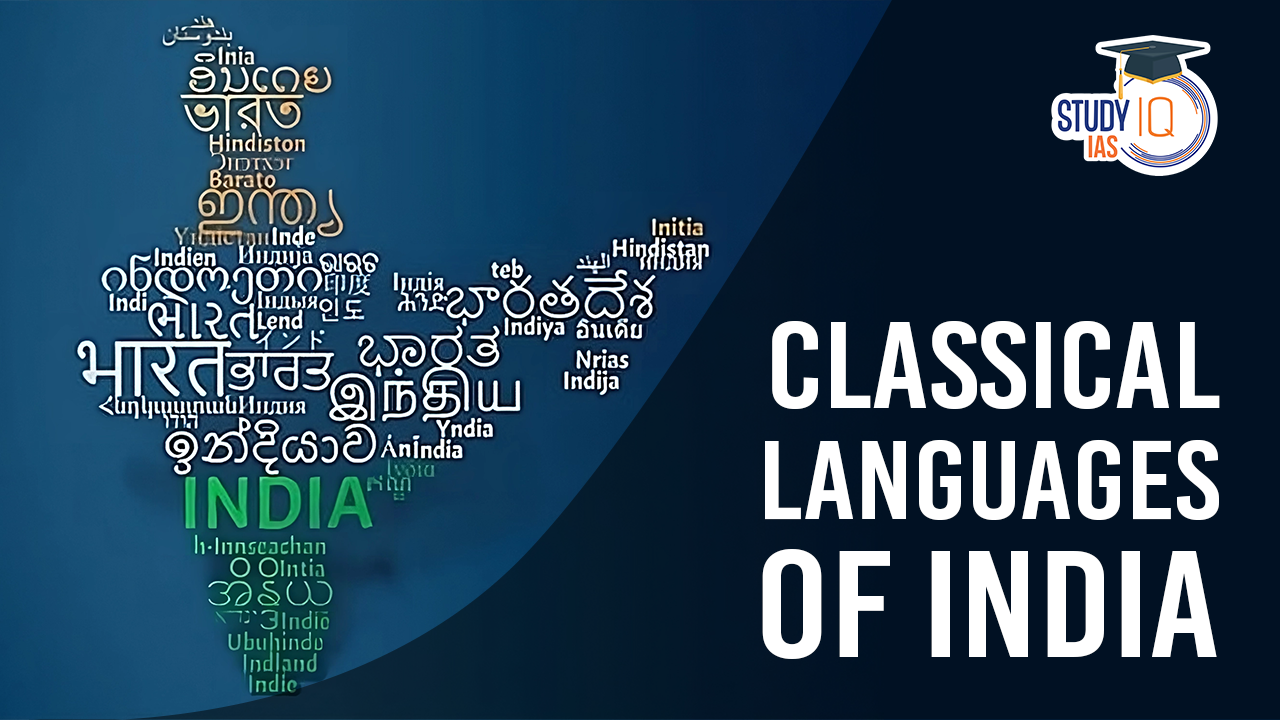Table of Contents
Union Cabinet Approves Classical Language Status for Marathi, Bengali, Assamese, Pali, and Prakrit
The Union Cabinet has granted classical language status to Marathi, Bengali, Assamese, Pali, and Prakrit, nearly doubling the number of classical languages in India to 11. This recognition acknowledges the ancient and rich literary traditions of these languages. Benefits include academic and research opportunities, international awards for scholars, and the establishment of research centres for their study.
Prime Minister Narendra Modi emphasized the importance of preserving India’s linguistic diversity, with leaders from Assam and Maharashtra expressing gratitude for recognising their languages. This move aims to promote and conserve the cultural heritage of these languages on a global scale.
What is Classical Language of India?
- Earlier in India, 6 languages enjoy the ‘Classical’ status: Tamil ( 2004), Sanskrit (2005), Kannada (2008), Telugu (2008), Malayalam (2013), and Odia (2014).
- These languages are considered classical because they have an independent literary tradition and a vast amount of ancient literature.
- Sanskrit is the oldest of the classical languages.
- All the Classical Languages are listed in the 8th Schedule of the Constitution.
| 8th Schedule of the Constitution |
Constitutional Provisions Related to the Eighth Schedule:
|
| Official Languages |
|
Check here: National Languages of India
India’s New Classical Languages: Marathi, Bengali, Assamese, Pali, and Prakrit
| Classical Language | Description |
|---|---|
| Marathi | Recognized as a classical language in October 2024, Marathi is primarily spoken in Maharashtra. It boasts a rich literary tradition dating back to the 13th century, with contributions from poets like Sant Tukaram and modern writers. The language has a diverse body of literature, including drama, poetry, and prose, and holds significant cultural importance in Maharashtra. |
| Bengali | Officially granted classical status in October 2024, Bengali is widely spoken in West Bengal and Bangladesh. It has a rich literary heritage, featuring notable poets like Rabindranath Tagore and Kazi Nazrul Islam. The language is known for its extensive body of literature, music, and arts, making it a vital part of Bengali culture and identity. |
| Assamese | Also recognized as classical in October 2024, Assamese is the principal language of Assam. With a history dating back several centuries, it has a vibrant literary tradition that includes ancient texts and modern literature. The language is rich in folklore, poetry, and drama, reflecting the diverse culture of Assam. |
| Pali | Pali was granted classical language status in October 2024. It is an ancient language closely associated with Theravada Buddhism and is the language of the Pali Canon, which contains the teachings of the Buddha. Pali has a significant role in religious studies and historical texts, making it essential for understanding early Buddhist literature and philosophy. |
| Prakrit | Also recognized in October 2024, Prakrit refers to a group of ancient languages spoken in India. These languages are essential for understanding the evolution of modern Indian languages. Prakrit holds historical significance, especially in Jain and Buddhist texts, and offers valuable insights into India’s linguistic and cultural history. |
Details about 11 Classical Languages of India
Check the below table to get the complete details about 11 Classical Languages of India 2024:
| Classical Language | Description |
|---|---|
| Sanskrit | An ancient classical language often referred to as the “language of the gods.” Originating in the Vedic era, it was recognized as classical on January 26, 2005. Sacred in Hinduism, Buddhism, and Jainism, it features well-defined grammar, an extensive vocabulary, and a significant impact on Indian languages. Used in ancient texts such as the Vedas, Upanishads, and Mahabharata. |
| Tamil | Known as the “Ancient Dravidian Jewel,” Tamil is spoken mainly in southern India and was recognized as a classical language in 2004. With a history spanning over two millennia, it boasts a vibrant literary tradition, including Sangam literature, and has distinct script and significant contributions to literature, art, and music. |
| Telugu | The language of Andhra Pradesh, Telugu was officially recognized as classical in 2008. It has ancient origins and is celebrated for its lyrical beauty, particularly in poetry. The Telugu script is one of the oldest writing systems in the world. |
| Kannada | The official language of Karnataka, Kannada was recognized as classical in 2008. With a history of over 2,000 years, it has been shaped by contributions from ancient poets like Pampa, Ranna, and Harihara. The Kannada script derives from the ancient Brahmi script and features unique characters. |
| Malayalam | Primarily used in Kerala, Malayalam was recognized as a classical language in 2013. Its history dates back to the ninth century and is believed to have evolved from Proto-Tamil-Malayalam, showcasing a rich literary tradition. |
| Odia | Spoken primarily in Odisha, Odia was recognized as classical on February 20, 2014. Its origins date back over 2,500 years, evolving from Prakrit and Sanskrit, and is acknowledged for its historical, literary, and cultural importance. |
| Marathi | Recognized as a classical language in October 2024, Marathi is primarily spoken in Maharashtra. With a rich literary history dating back to the 13th century, it has a diverse body of literature and cultural significance. |
| Bengali | Officially recognized as classical in October 2024, Bengali is widely spoken in West Bengal and Bangladesh. With a literary tradition that includes notable poets like Rabindranath Tagore, it boasts a rich cultural heritage. |
| Assamese | Also granted classical status in October 2024, Assamese is the principal language of Assam. It has a rich literary tradition and a history dating back several centuries, with contributions from various poets and writers. |
| Pali | Recognized as classical in October 2024, Pali is an ancient language associated with Theravada Buddhism. It has a significant body of literature, including the Pali Canon, and is important for historical and religious studies. |
| Prakrit | Also recognized in October 2024, Prakrit languages were spoken in ancient India and are important for understanding the evolution of modern Indian languages. They hold historical significance in Jain and Buddhist texts. |
Criteria for Declaring Classical Languages in India
The Ministry of Culture provides guidelines regarding Classical languages.
- The language must have early texts or recorded history dating back 1500-2000 years.
- The language must possess a significant body of ancient literature or texts that are considered a valuable heritage by its speakers.
- The literary tradition of the language should be original and not derived from another speech community.
- The classical language and its literature should be distinct from its modern form, with a potential discontinuity between the classical language and its later forms or derivatives.
| Criteria | Description |
| Antiquity | Language must have a documented history spanning 1,500 to 2,000 years, showcasing resilience and enduring relevance over historical periods. |
| Literary Tradition | A substantial body of ancient literature of exceptional quality in various genres such as poetry, drama, philosophy, scientific treatises, and religious texts. |
| Influence on Other Languages | Language must have influenced the development of other linguistic systems, shaping the linguistic landscape of the region. |
| Distinct Grammar and Structure | Possession of a well-defined and distinct grammar and linguistic structure, ensuring originality and differentiation from other languages. |
| Living Tradition | Strong and vibrant literary and cultural traditions are actively practised and celebrated by a significant number of people, emphasizing the language’s ongoing relevance in contemporary society. |
Benefits Accorded to Classical Languages in India
Once a language is designated as a Classical language, the Human Resource and Development Ministry offers several benefits to promote it:
- Two major annual international awards are established for distinguished scholars in classical Indian languages.
- A Centre of Excellence for Studies in Classical Languages is created.
- The University Grants Commission has been asked to establish a certain number of professional chairs for classical languages, initially in central universities.
The recognition of a language as classical in India comes with several other advantages, showcasing its historical, cultural, and linguistic significance:
- Preservation of Cultural Heritage: Classical languages are viewed as important repositories of ancient literature, scriptures, and cultural heritage. Recognition aims to safeguard and promote this rich cultural legacy.
- Official Language Status: Classical languages often receive official language status in states where they are predominantly spoken, ensuring their use in government offices, educational institutions, and other official domains.
- Grants and Funding: Financial assistance and grants are provided by the government to support research, documentation, and promotion of classical languages. This aids in scholarly activities, the publication of books, and the translation of ancient texts.
- Educational Opportunities: Classical languages are included in the curriculum of educational institutions at different levels, contributing to their preservation and continuity.
- National Fellowships: Scholars and researchers specializing in classical languages are eligible for national fellowships and scholarships, supporting their academic endeavours and research initiatives.
- Cultural Events and Festivals: Cultural festivals and events celebrate the magnificence of classical languages, fostering awareness and captivating the curiosity of people, particularly the youth.
- Promoting Tourism: Classical languages contribute to heritage tourism, attracting visitors interested in exploring historical and cultural aspects associated with these languages.
- International Recognition: Being recognized as a classical language brings international prestige and visibility, fostering collaborations with international scholars and institutions for academic exchange.
| Central Institute of Indian Languages (CIIL) |
|
Importance and Significance of Classical Languages
Classical languages play a vital role in preserving cultural identity, promoting multilingualism, advancing academic and intellectual pursuits, preserving ancient knowledge, promoting art and literature, facilitating cultural exchange, and fostering global understanding. These languages are not only repositories of ancient wisdom but also contribute to the vibrant tapestry of India’s diverse heritage. Their recognition as classical languages is a testament to their enduring impact on various facets of Indian culture.
| Farsi Language |
| External Affairs Minister S Jaishankar announced during his visit to Iran that the Government of India has decided to include Farsi (Persian) as one of the classical languages in India under the New Education Policy. This move aims to deepen cultural ties, reflecting a commitment to fostering an understanding of Farsi’s rich heritage in the Indian educational framework. The recognition emphasizes the cultural, literary, and linguistic connections between Iran and India, with Tamil, Sanskrit, Kannada, Malayalam, and Odia already holding classical language status in India. |


 Bonalu Festival 2025: Date, History, Rit...
Bonalu Festival 2025: Date, History, Rit...
 Puri Jagannath Rath Yatra 2025, History,...
Puri Jagannath Rath Yatra 2025, History,...
 Ambubachi Mela 2025: Dates, Rituals, Sig...
Ambubachi Mela 2025: Dates, Rituals, Sig...





















